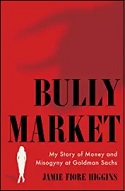By Pam Martens and Russ Martens: August 29, 2022 ~
 Tomorrow, Simon & Schuster will release a new book by Jamie Fiore Higgins, a woman who worked her entire Wall Street career at one firm. Over the span of just under 18 years, beginning on September 2, 1998 and ending officially on May 31, 2016 according to BrokerCheck, Fiore Higgins achieved a level of financial success rarely attained by a woman on Wall Street. She was fresh out of college, at age 22, when this journey began. She was a seven-figure Managing Director at the quintessential good ole boys club on Wall Street when it ended.
Tomorrow, Simon & Schuster will release a new book by Jamie Fiore Higgins, a woman who worked her entire Wall Street career at one firm. Over the span of just under 18 years, beginning on September 2, 1998 and ending officially on May 31, 2016 according to BrokerCheck, Fiore Higgins achieved a level of financial success rarely attained by a woman on Wall Street. She was fresh out of college, at age 22, when this journey began. She was a seven-figure Managing Director at the quintessential good ole boys club on Wall Street when it ended.
Now, six years after she resigned her post (possibly heretofore restrained by the customary non-disparagement agreement one is asked to sign when leaving a Wall Street investment bank) Fiore Higgins is spilling the beans on what she saw and heard and experienced at Goldman Sachs. The book title says it all: Bully Market: My Story of Money and Misogyny at Goldman Sachs.
But the book is so much more than the title suggests. Fiore Higgins had a front row seat to one of the most unprecedented time spans in Wall Street history. In fact, the 500-year financial storm was happening again and again during her years at Goldman.
Fiore Higgins was at Goldman when Wall Street blew up the Nasdaq stock market in the dot.com bubble and bust of the late 90s and early 2000s. She watched the United Airlines plane fly past her window on the 48th floor of Goldman just before it sliced into the World Trade Center’s south tower on 9/11. She then watched from the ferry she boarded to escape to her home in New Jersey as people leaped to their death from the fireballs that engulfed the towers. The stock market was closed for four days — the longest closure since 1933.
Fiore Higgins had completed a decade at Goldman Sachs by 2008, the year that century old Wall Street firms blew themselves up in the subprime and derivatives crash. Fiore Higgins was pregnant with twins that year but writes that as things went from bad to worse in the markets, she “started leaving for work at 4:15 a.m. and drove straight into the city, getting to my desk by 5 a.m.”
The financial crash of 2008 and the years that followed resulted in the greatest economic upheaval in the United States since the Great Depression. Millions of innocent Americans first lost their jobs and then their homes. The unemployment rate in the U.S. went from 5 percent to 10 percent. And the work that Fiore Higgins was doing for the Goldman Sachs’ trading desk at that time is what is most intriguing about this book.
Loaning stocks to hedge funds so that they can enter short sales (make a bet on the price of the stock declining) is big business on Wall Street. Investment banks like Goldman will loan out their own clients’ stock to hedge funds to short, as well as develop close relationships with institutional clients like pension funds, mutual funds and regional banks to get them to agree to let Goldman borrow their stocks for use in hedge fund short sales.
Getting close with these institutions involves expensive dinners footed by Goldman on a regular basis, fine Scotch costing $100 per glass, expensive golf and vacation outings.
Goldman pays a fee to the institutional client that is loaning their stock and then charges a heftier fee to the hedge fund client that is borrowing the stock. The spread between those two fees can result in big profits for Goldman. This was one of the areas of expertise of Fiore Higgins. She writes as follows about her experience during the 2008 crash:
“Part of my job, once we got our hedge funds short, was to keep them short. That meant we always had to borrow the stocks that the hedge funds wanted to short. In return, the hedge funds would pay us a fee, a percentage rate applied to the market value of the trade. The harder the stock was to find, the more expensive the fee. Clients would pay high fees (upwards of 100 percent). Since there wasn’t a published market for short fees, you couldn’t just look it up on an exchange like a stock price. The broker quoted the fee at the time of the initial trade, but they could change day to day.”
If there is anything Wall Street loves more than profits, it is discretion on what it can charge on a trade.
Fiore Higgins’ boss told her this one day about her dealings with the unsophisticated institutions from whom she was borrowing stock: “Don’t even think about telling them how valuable that stock is. If they are too stupid to know how much to charge us for their stock, then that’s their problem.”
What goes unreported in the book is the degree to which Goldman was ripping off its clients and driving down stock prices further in a collapsing market by facilitating short sales, while it was simultaneously receiving tens of billions of dollars in bailout loans from the Federal Reserve and equity infusions from the U.S. taxpayer.
In the leadup to the 2008 crash, Goldman Sachs offloaded billions of dollars of toxic subprime mortgage paper onto its customers, with employees even referring to one offering as a “shitty deal” in emails, while Goldman shorted the paper (betting against it) to make massive profits for itself. Billions of dollars of this rotten paper were sold to retirement funds for low-wage municipal workers.
On Wednesday, April 13, 2011, following a two-year investigation, Senators Carl Levin and Tom Coburn, Chairman and Ranking Member of the Senate’s Permanent Subcommittee on Investigations, released a 635-page report which included specifics on the deceitful and fraudulent role that Goldman Sachs played, among others, in burning down Wall Street and the U.S. economy in the greatest collapse since the Great Depression. Goldman Sachs is referenced 2,495 times in the report.
The report characterizes the actions of the denizens of Wall Street as an “economic assault” on the United States. The report came a year after the Subcommittee had conducted a series of hearings in April 2010, including taking direct testimony from Goldman Sachs officials. (See video clip below.) The report summarizes its findings about Goldman Sachs as follows:
“When Goldman Sachs realized the mortgage market was in decline, it took actions to profit from that decline at the expense of its clients. New documents detail how, in 2007, Goldman’s Structured Products Group twice amassed and profited from large net short positions in mortgage related securities. At the same time the firm was betting against the mortgage market as a whole, Goldman assembled and aggressively marketed to its clients poor quality CDOs that it actively bet against by taking large short positions in those transactions. New documents and information detail how Goldman recommended four CDOs, Hudson, Anderson, Timberwolf, and Abacus, to its clients without fully disclosing key information about those products, Goldman’s own market views, or its adverse economic interests. For example, in Hudson, Goldman told investors that its interests were ‘aligned’ with theirs when, in fact, Goldman held 100% of the short side of the CDO and had adverse interests to the investors, and described Hudson’s assets were ‘sourced from the Street,’ when in fact, Goldman had selected and priced the assets without any third party involvement. New documents also reveal that, at one point in May 2007, Goldman Sachs unsuccessfully tried to execute a ‘short squeeze’ in the mortgage market so that Goldman could scoop up short positions at artificially depressed prices and profit as the mortgage market declined.”
Much of the book focuses on the sick Goldman culture that eventually envelopes Fiore Higgins, including her affair with a Goldman colleague. She assesses what she had become as follows:
“I felt like human poison. I ruined everything I touched – marriages, careers, and relationships. After working for years in this awful environment, I’d become just as toxic as Goldman Sachs.”
This book, together with “Why I Left Goldman Sachs” by Greg Smith, and Carmen Segarra’s Noncompliant, should be must reading for every staff attorney at the Securities and Exchange Commission and U.S. Attorney’s office for the Southern District of New York. If you have no idea what you’re dealing with, you’re not likely to know how to prosecute it.


